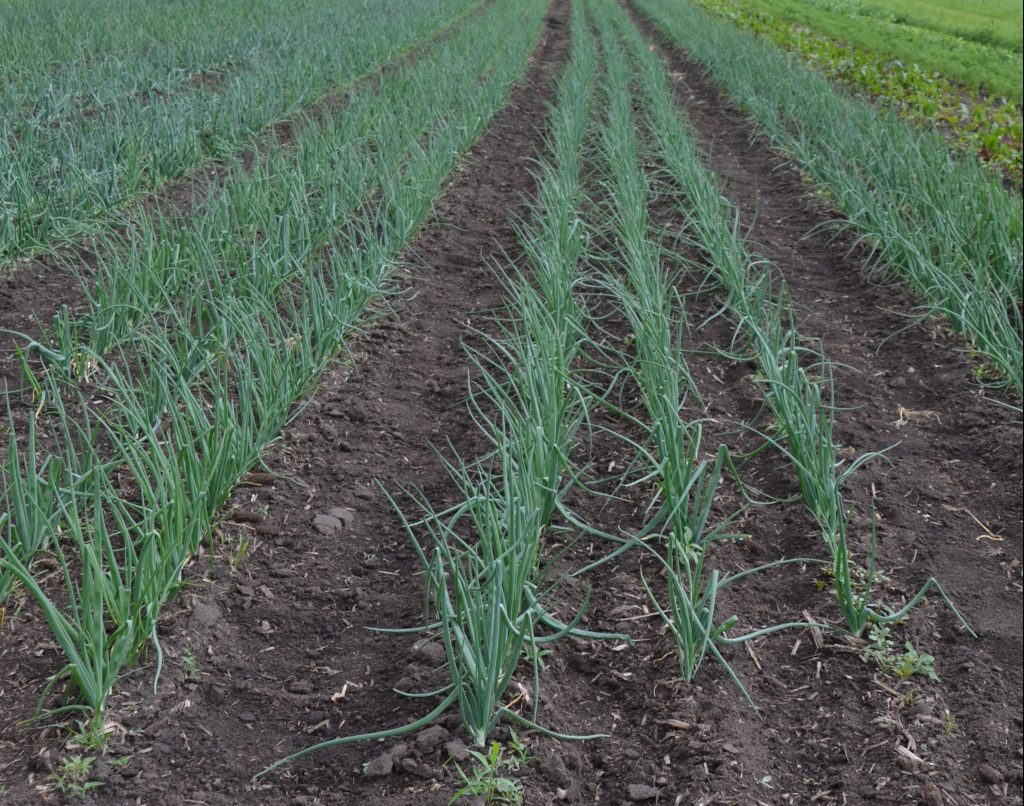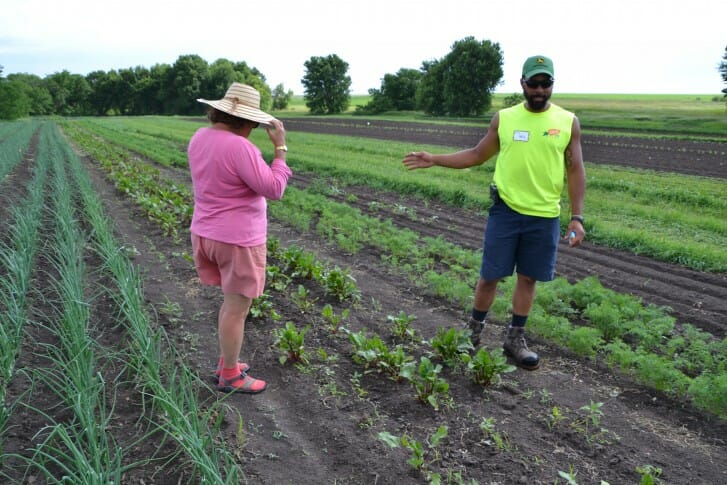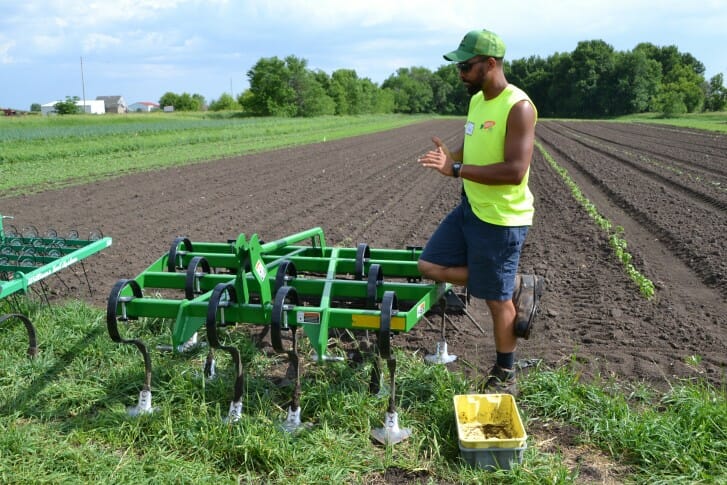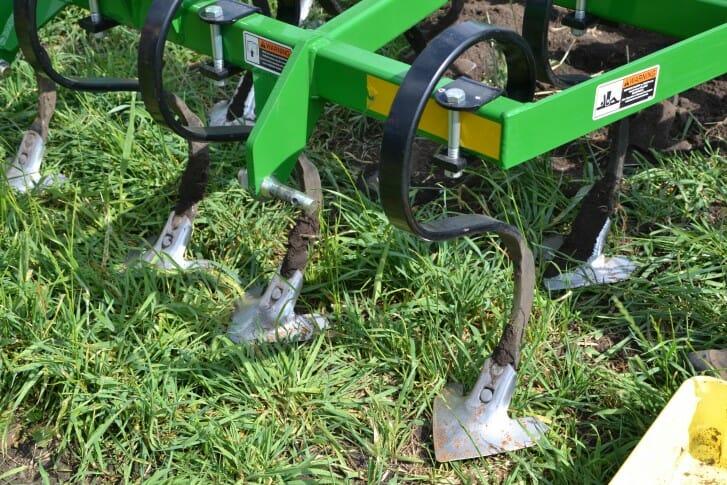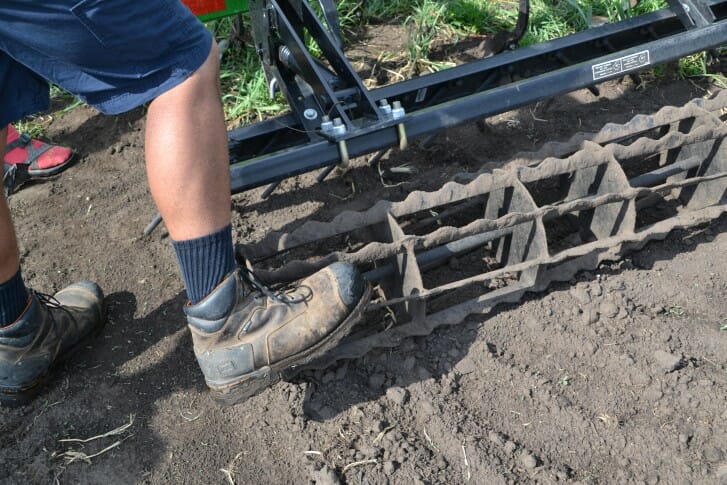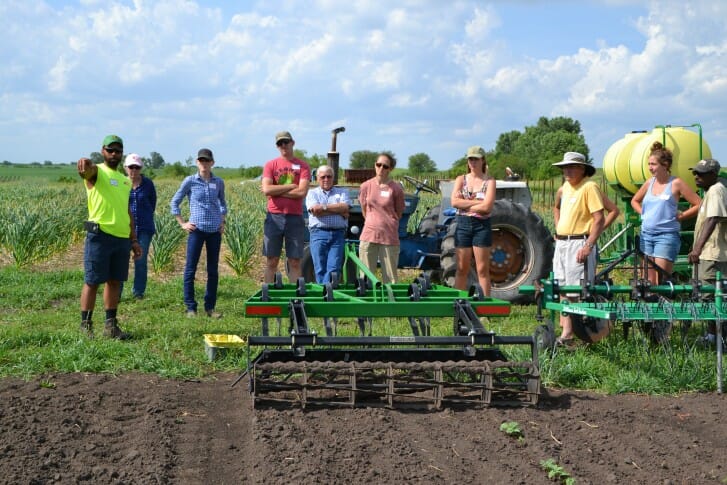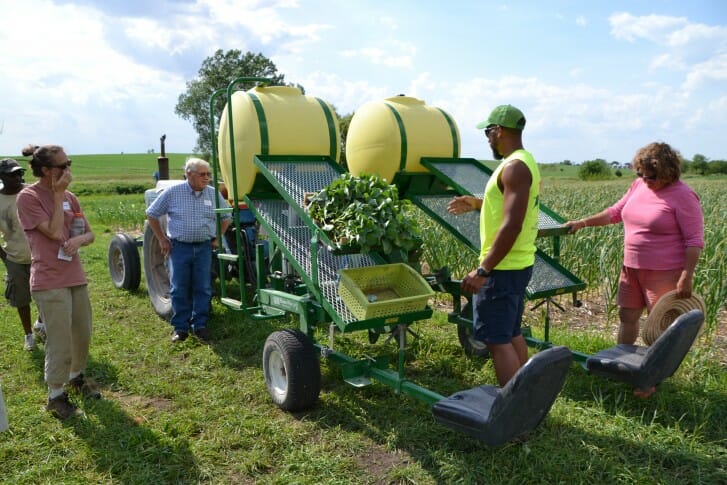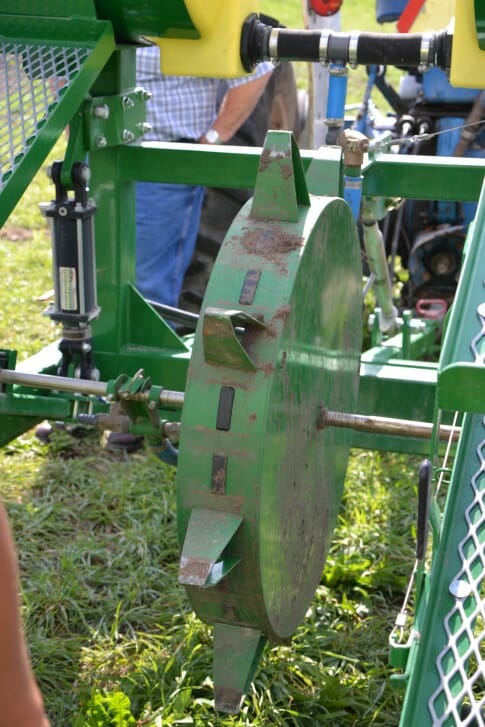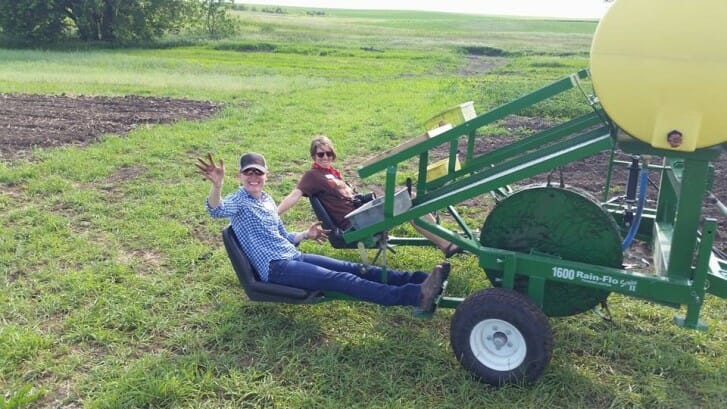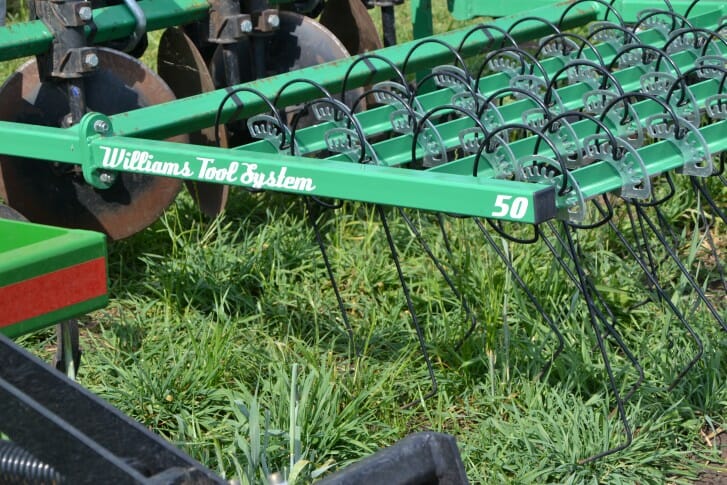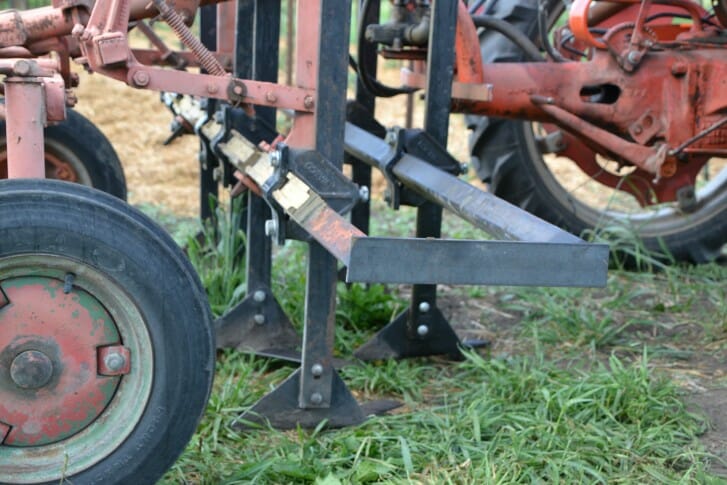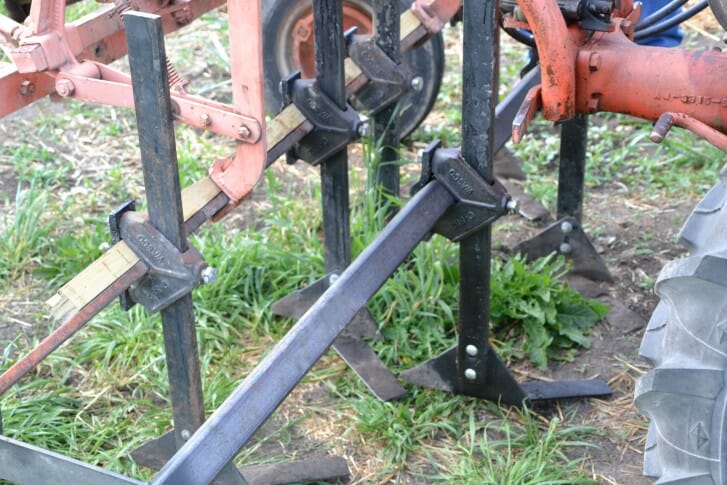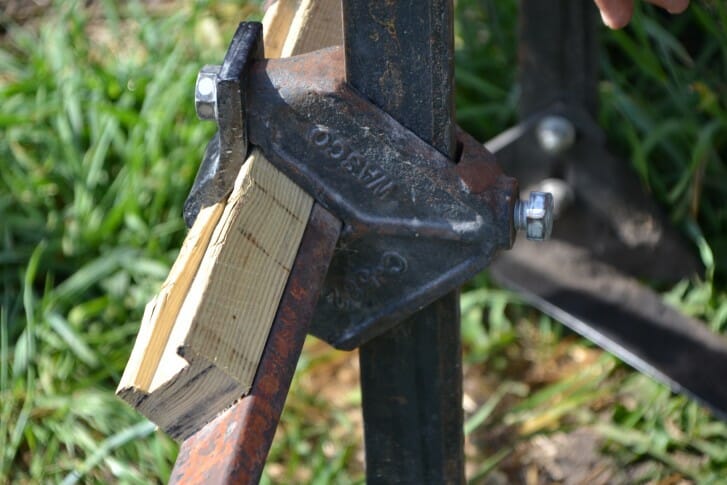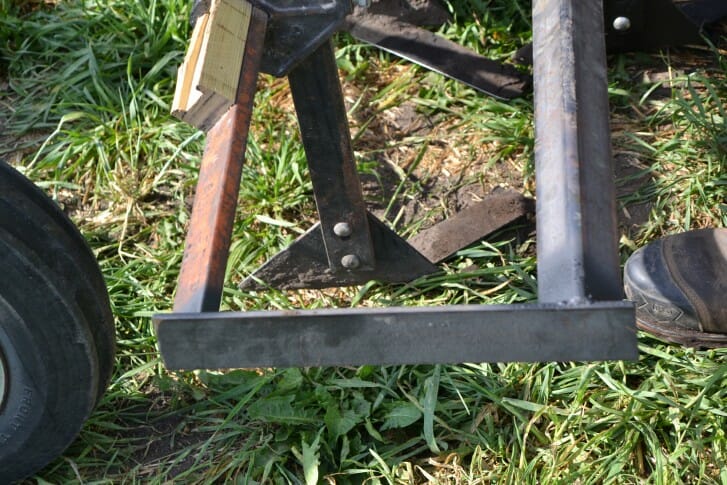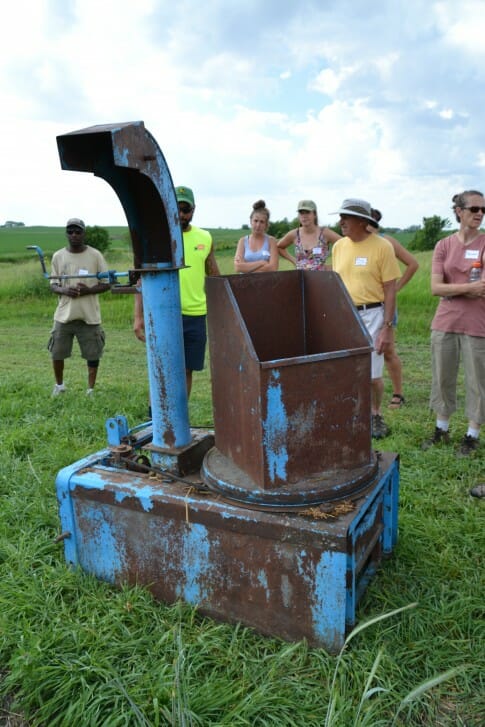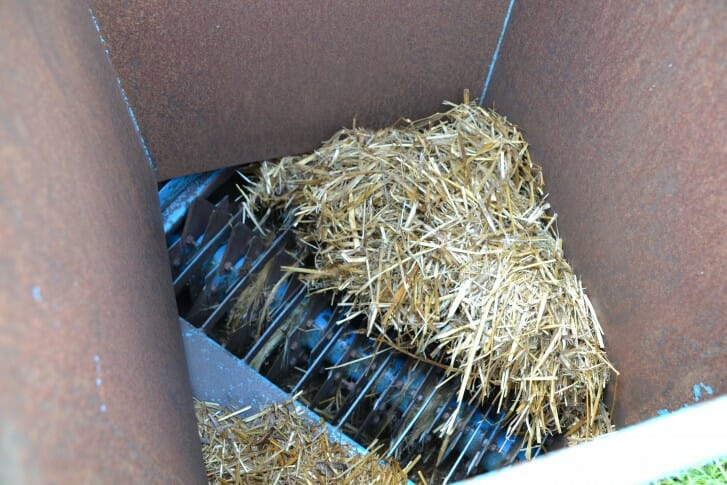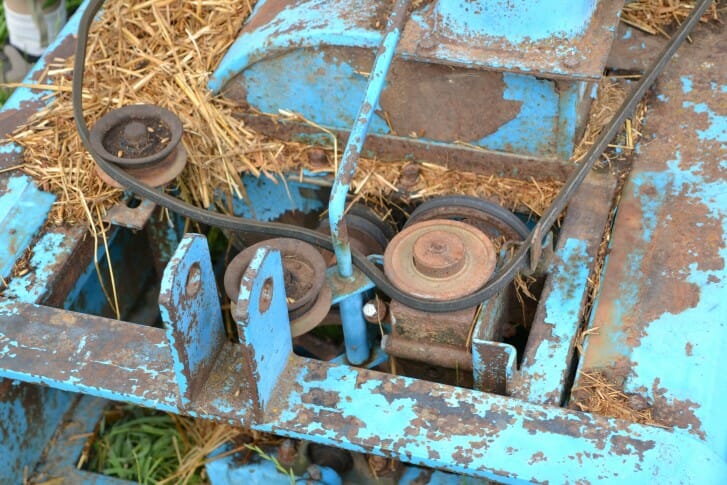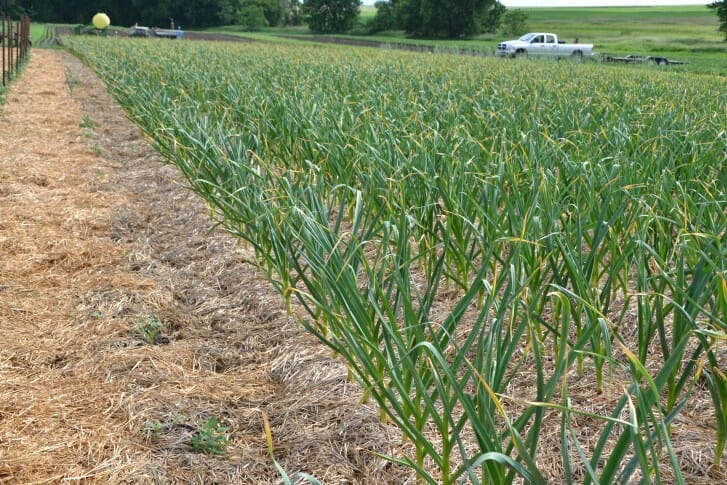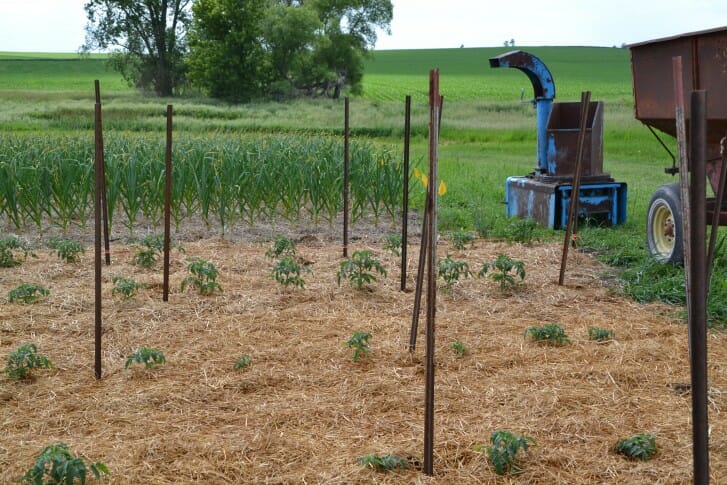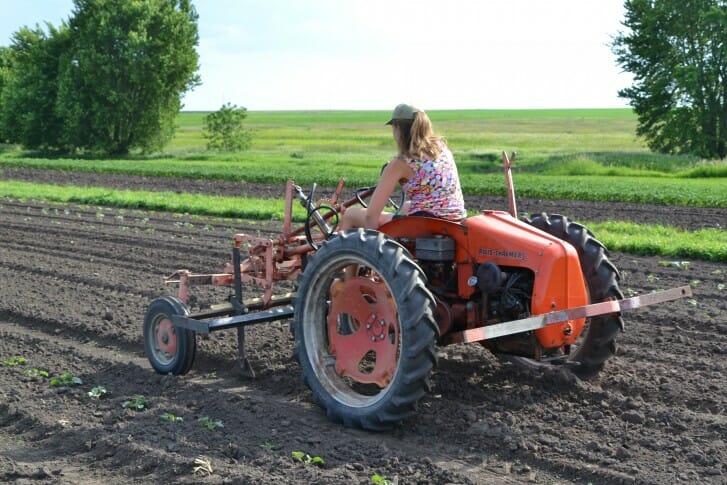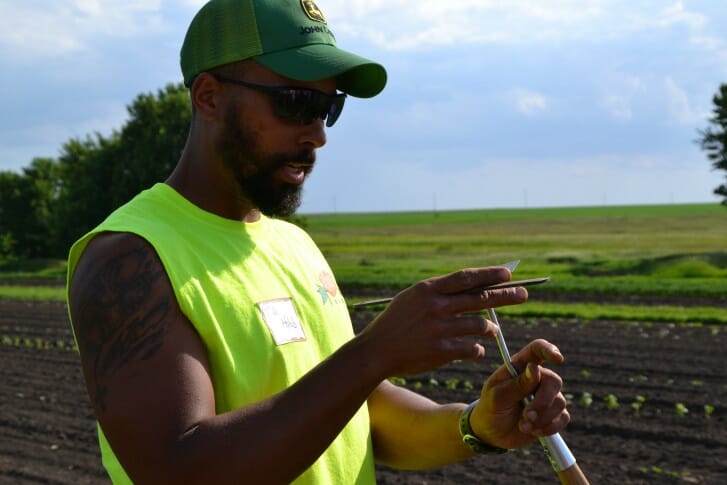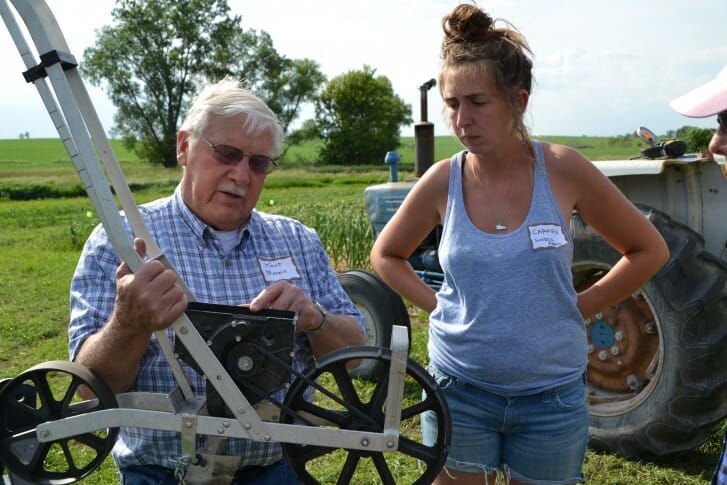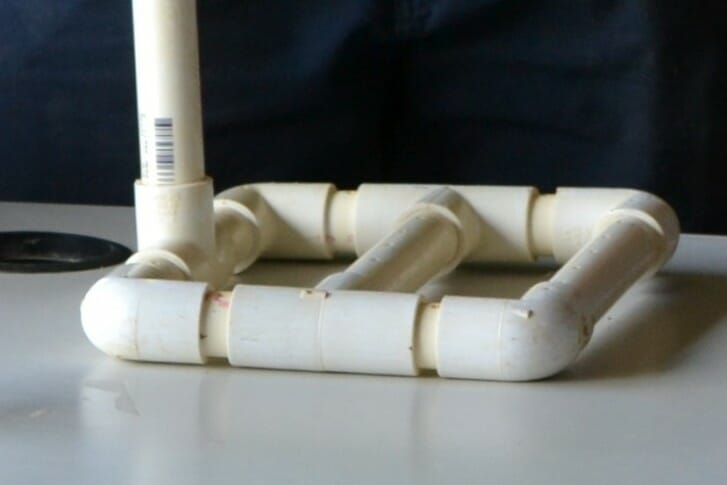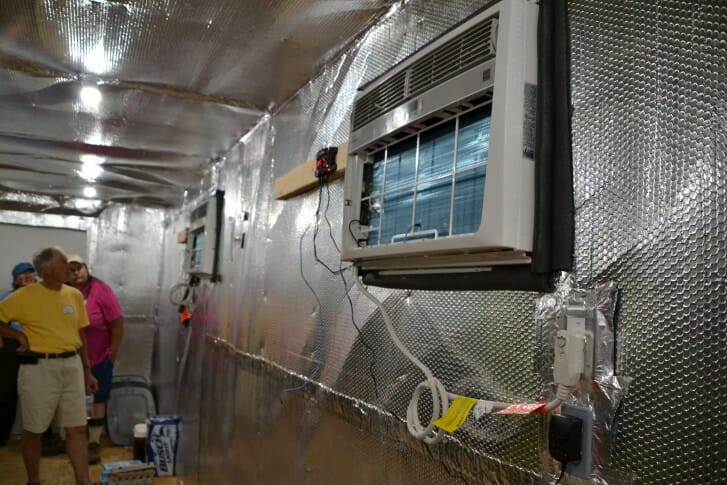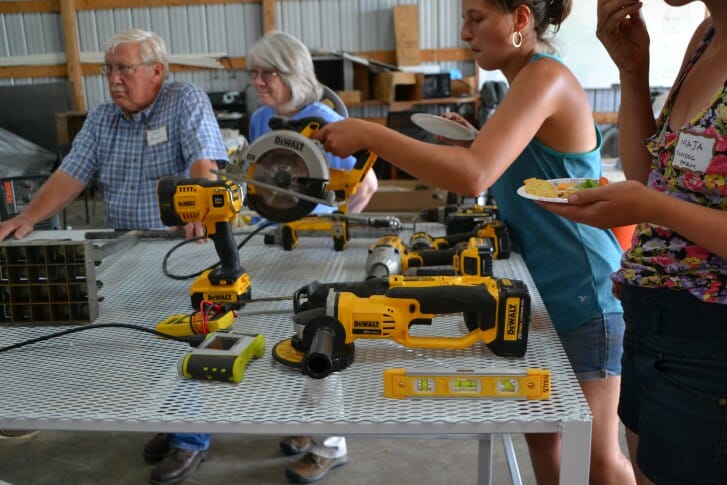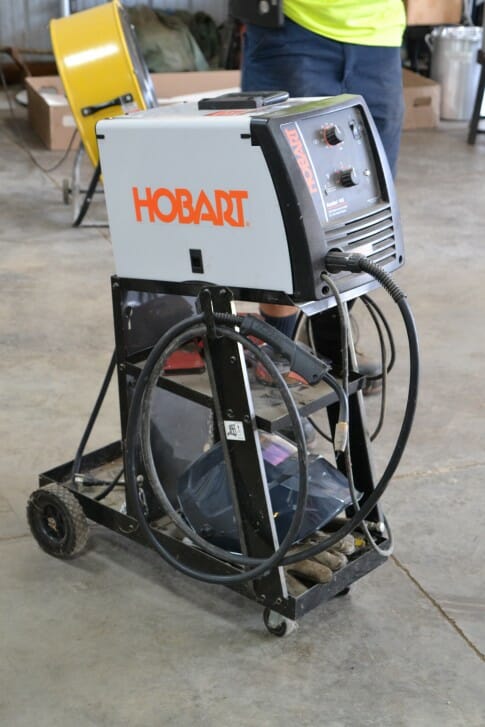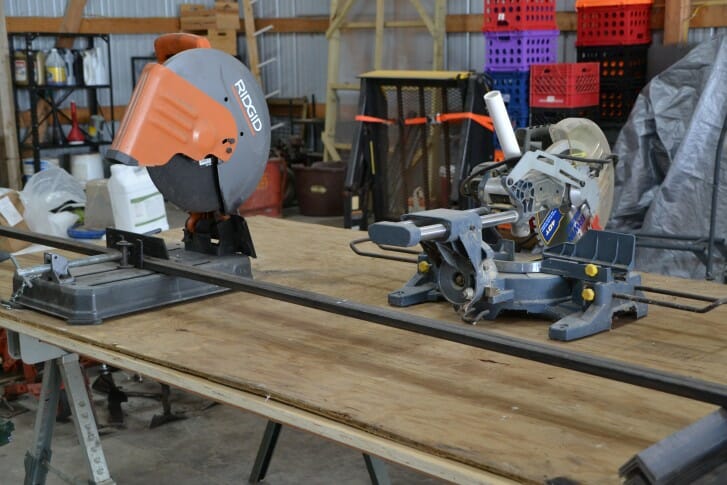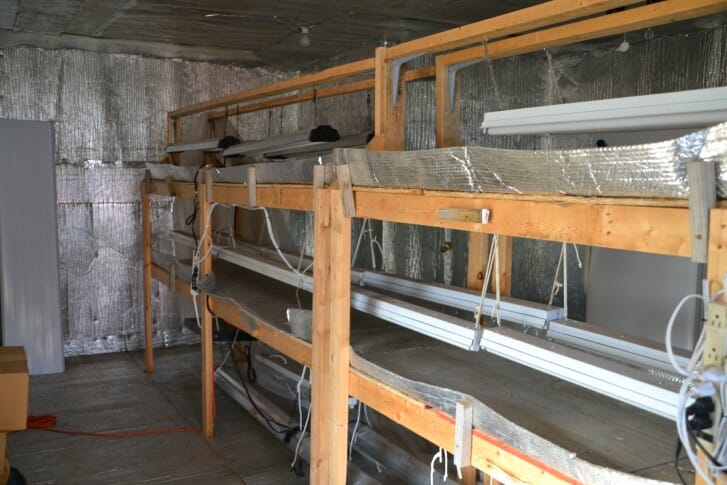Tools and Tractors with T.D. at Garden Oasis Farm
Indeed, this was T.D. Holub’s first field day with PFI, which he hosted with his fiance, Sarah Gericke, near Coggon at their Garden Oasis Farm. The topic of the field day was “Tools and Tractors” and attendees tried out several of each, including his Allis Chalmers G, RainFlo water wheel, several seeders, wheel hoes, hand tools, and shop equipment – including a batch egg washer he built. Garden Oasis Farm maintains a 100-member CSA , 4-5 wholesale accounts, and does markets in Cedar Rapids, Iowa City, and Independence. In addition to vegetables, T.D. and Sarah raise eggs and meat chickens, and have a few goats.
T.D. and Sarah rent land from T.D.’s family. From where he farms, he can see his old house, and his return to the farm aligned perfectly so he could buy the neighbor’s house, which is about 3/4 mile from his production fields. He is planning to drop a well for irrigation, but until then, waters-in transplants in with the water wheel, and then if needed, drives over each row slowly with the wheel raised and dripping water to give them an extra boost. Beyond that he has been lucky enough to get by with rainfall, only. (To hear all of this in T.D.’s words, check him out on the PFI Podcast: On-Farm.)
The field day started in the field and them moved inside to the machine shop and walk-in cooler. Read on for photos and details!
T.D. seeded beets and carrots, below with a Jang seeder, using the X24 plate (the radish plate). He is pleased with the carrots, but for the second year in a row, unhappy with beet establishment. If T.D. is direct seeding, after he uses the Perfecta (below) he comes back through and marks rows by just touching the top inch of soil with the cultivator, using welded-on row markers (made from cut down plow points). “If you can drive a straight line, you’ll never have to run a string-line ever again.”
“This is my Perfecta field cultivator. They told me my tractor would pull it… they lied. It does pull it but it’s not very happy about it. It’s a nice, substantial cultivator and it works great. To transplant, I don’t till anymore – all I do is run through with the Perfecta. You can run it as fast as your tractor will pull it, and the faster you go, the better it works. I got the heavy duty tiines with the bigger sweeps – in my opinion it’s as good as a tiller. Behind the sweeps there’s an adjustable leveling bar, which you can set to whatever depth you want. The rolling basket makes all the difference. It really chops up the soil, but leaves enough variance in the soil that even with all the rain we got there isn’t a crust on top. Right now I’m pulling this with a 50 hp tractor, but would like to use 60 or 70 hp. I’d like to go 6 or 7 mph but am only at about 3.5 mph. The 6-ft Perfecta extends to the outside edge of my wheels, so there are no wheel marks. The wheel marks you see in the field come later, from the water wheel.”
“If I didn’t have this transplater, most of my transplants would be dead.” After several conversations with Ralph at Market Farm (and the Williams Tool System – Ralph was great to work with), T.D. opted for the water wheel transplanter with a single wheel, and with hollow spikes to accommodate the soil blocks. If they need to do a double row, they backtrack over the same row and swing the seats to accommodate the new row. When T.D. gets a larger tractor, he may upgrade to a double-wheel transplanter.
The spikes on the wheel make a hole for the transplant, and water from the tanks trickles through the wheel. Riders set the transplants into the watered holes that immediately seal up with the muddy soil. The spikes switch out for different sizes and spacing for different crops. “The one downfall is that I use soil blocks, and they need to be pre-split. But it still is a huge time saver, and I’ve had people aged from 14 to 66 transplant on the water wheel. The seats are very adjustable to accommodate different sizes of people.”
We planted (and watered-in) 160 cucumber transplants for T.D. in just a few minutes. A trick for lettuce: “I only set the spike in enough so that it will turn the wheel. The person planting has to push it in a little deeper, but by leaving it shallow it reduces leaf disease and centipedes in the heads.” T.D. uses the water wheel with no water to dry-poke holes to plant potatoes. He then hills them over with the Williams Tool Bar.
Right now T.D. only uses the Williams Tool Bar System for the tine weeder and to hill potatoes. “All the sweeps from the Williams are now on the G. I wasn’t happy with the job the sweeps that came on the G were doing, but I knew I was more accurate when the sweeps were under me (on the G) rather than behind me (with the Williams Tool Bar). So I pulled the sweeps off the Williams Tool Bar and set them up on the G. I’m looking for some more places to use the Williams Tool Bar, but the tools aren’t interchangeable with everything because the 2-in square bar is mounted on the side so it needs special clamps.” Laura Krouse mentioned that some old John Deere cultivators have that setup, called the Diamond, that may work to swap in. “If I had to do it all over again, I might not have bought this, but then I wouldn’t have the sweeps for the G. I think over time I’ll find more places to use it.”
“The G came with the slimmer bar in the front; I just used boards as a temporary solution to make the Williams beet knife sweeps fit, then welded another bar on behind to achieve the setup I wanted (3 row). You can also adjust the pitch to throw a little more dirt. It’s night and day using this compared to the Williams Tool Bar System.” Kent Morris noted that beet knives are also called “tender hoes”.
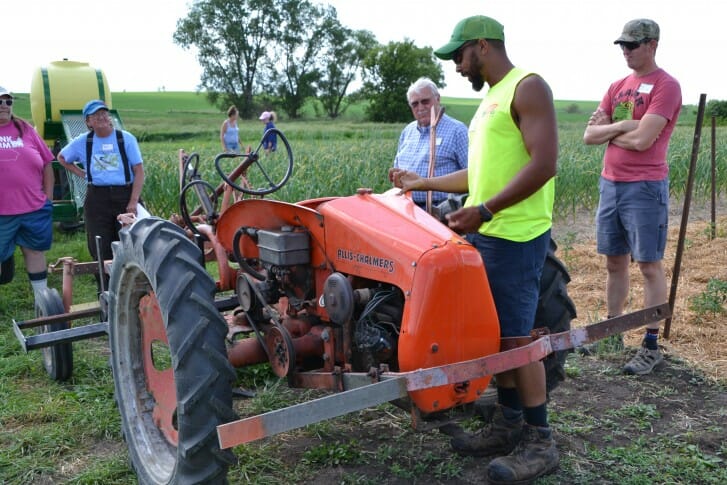
Below is T.D.’s straw mulch spreader, which he pulls with a 50 HP tractor. The spreader hooks up to a 3-point hitch on the tractor. The square bale goes in, an auger spins, chops the straw bales, and puts it into the blower. “I want to get rid of all these belts and replace them with chains. If you get a bale wedged in too hard at the beginning the belts slip a little, and if I have people working, I don’t want anyone sticking their hands in there. I’m pretty happy with how it works – it much easier than chopping bales by hand and spreading by hand. I didn’t even know they made little square bale ones until I saw this, and went up to Minnesota to get it. Loose straw doesn’t work as well as the square bales, but it does still work. I’m planning to weld a hitch to the back of the spreader so I can pull a hay rack with me, and the guys can load from the hay rack as we’re going.”
“This is amazing,” said Susan Jutz at the end of T.D.’s field day, as we loitered in his spacious and tidy machine shop. “He does so much… and he’s so young.”
“I wait until the plants are big enough that they won’t get smothered by the mulch. Prior to that we run through a few times with a tine weeder.” Below, garlic and tomatoes have been mulched with straw from the spreader.
T.D.’s favorite hand tool is a sharp colinear hoe. “Thumbs-up position, tall handle, and just pull toward you. You can get around transplants very nicely and be very accurate. I keep a file with me in the field to sharpen my tools.” His wheel hoes, which have stirrup hoes that he prefers in the high tunnel and for direct-seeded crops in the field, are from Valley Oak Tools. “The handle height and angle are easy to adjust, so workers with different heights can use them comfortably. The handles also swing to the side so you can work from the outside of the row.”
Below, Kent Morris chats with Carmen Black about seed shape in the Earthway seeder. T.D. uses the Jang for most crops, but uses the Earthway for green beans.
Moving inside, T.D. showed attendees the shop tools important to his farm, a few of the things he’s built recently, and his new walk-in cooler.
T.D.’s batch egg washer is made of PVC, “I made this for ~$5. Set the basket on top of the PVC square on the bottom, which has holes drilled in it. Connect the air compressor with warm water and it starts bubbling… Do not turn the air compressor up higher than 30 PSI, or you’ll start breaking eggs. I get 3-4 baskets of eggs a day, and we have them all washed in 6 minutes.”
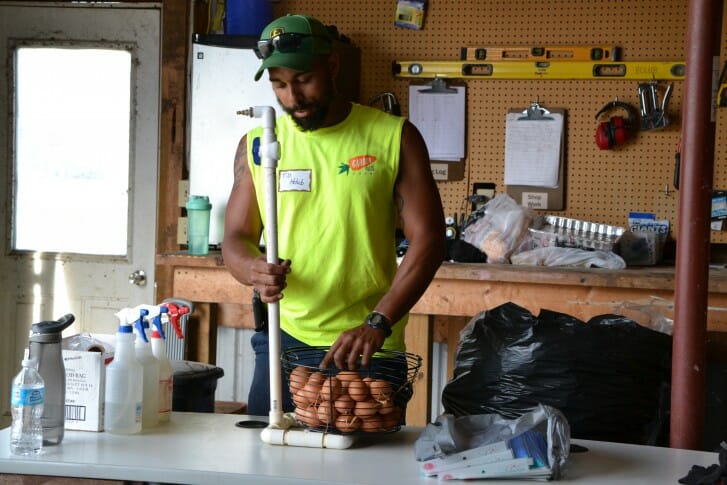
Base of the egg washer, notice the holes drilled in the center PVC pipes.
“We built this cooler – it’s 12′ x 24′ with 2 CoolBots. I’ve been very happy with it. I built a smaller one before based on the plans from CoolBot – I took the things I liked about that one and changed the things I didn’t. We use 2 25,000BTU air conditioners. I turned it on when 62 degrees in the cooler, came back 5 minutes later and it was 32 degrees, came back in another 5 minutes and it was 28 degrees… so it works pretty good! I have them set to 38 degrees, all the time I’m walking it it’s been 36 degrees. Having the cooler inside a building makes a big difference, and the TekFoil makes a difference, too. The lights are LEDs, and are on a motion sensor.” The only thing left for T.D. to do in the cooler is seal the floor.
T.D. recommends buying the best quality tools you can afford. He started with Bosch and wore through them – he now buys DeWalt. His favorite tool is the cordless impact driver, which allows him to make quick changes to farm equipment in the field, never having to use a wrench. He uses a paint stirrer on a cordless drill to stir Dipel and other chemicals in the tank. Most recently he bought a cordless grinder. “Every time I really needed a grinder I needed cordless. Having the grinder, sawzall, and circular saw cordless makes it much easier if I need to fix something on the chicken coop, say. I don’t have to run extension cords all over the place. I also only use Lithium batteries – they have more power, last longer, and when they do need re-charged, instead of fading out they simply stop working when they’re out of power.
T.D. recently taught himself to weld using a Hobart wire welder. “All my buddies that know how to weld joke with me for using a wire welder – it’s like a metal glue gun. I bought this one because it plugs into a regular outlet and can still do a 1/4 stick of steel – you can do more but you have to take more time. I can also take a generator into the field and use it if something breaks down.”
T.D.’s most recent project was a metal mesh-top lettuce drying table, below. It’s on wheels so he can easily move it around. He plans to make a couple more.
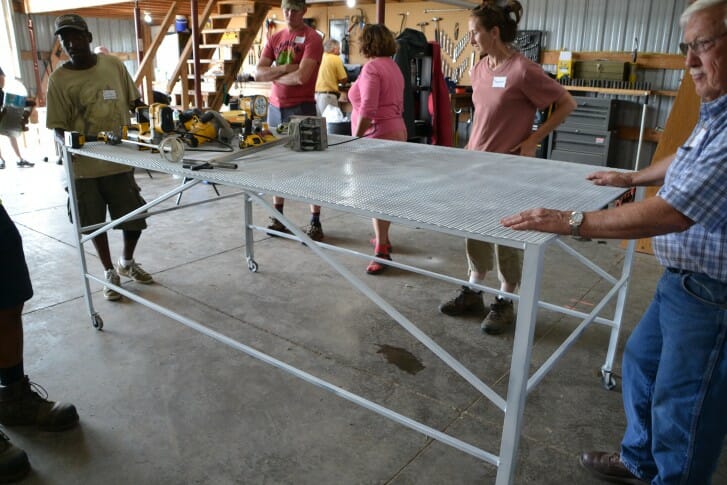
T.D. has a chop saw and miter saw, and got a table saw this winter, which made the cooler much easier to build.
T.D.’s germination room is an unused room in his house, that has a door into the house and a door to the outside. The walls are covered in TekFoil, like the cooler. “We can start 5,000 – 6,000 transplants in here. They stay here to germinate and then go to the high tunnel. Early in the season when everyone is hustling to get their plants covered up, I was just relaxing in the next room watching T.V.”
Many thanks to T.D., Sarah, and the field day attendees for sharing their knowledge during this field day!

